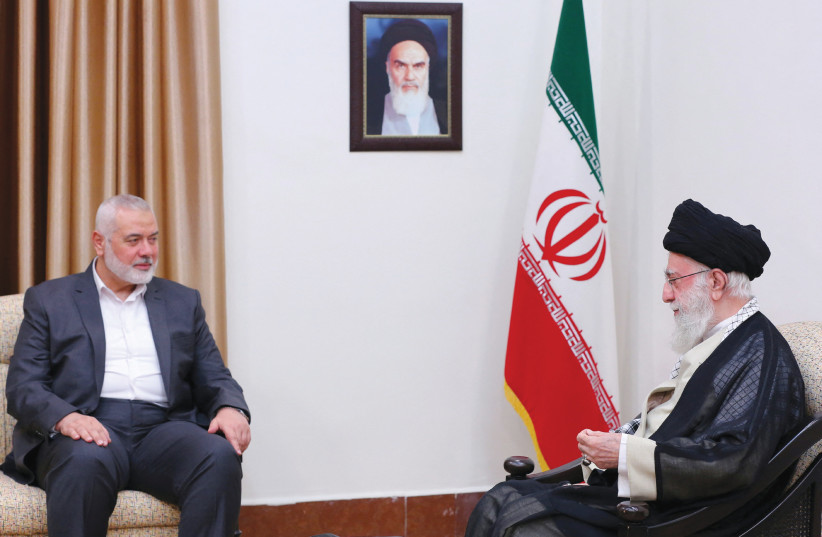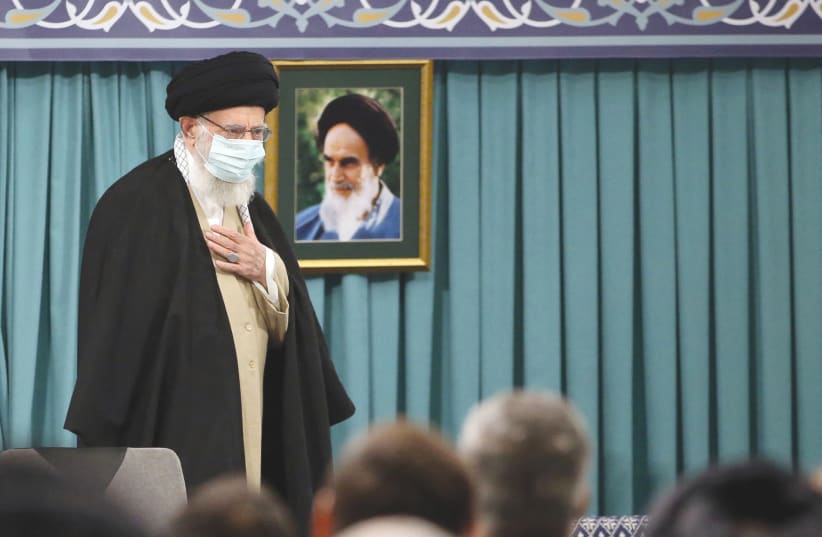While Israel has faced terrorism throughout much of its existence, the scale of this attack is unprecedented. It is comparable in significance to the surprise attack Israel faced during the Yom Kippur War in 1973.
There are three crucial points to consider. First, Hamas – the Islamic Resistance Movement or Harakat al Muqawama al Islamiyah, is not an independent agent but, along with other terror proxies, a part of the so-called “Axis of Resistance.” It is Iran’s tool for spreading its hegemony across the Middle East. As per its charter, Hamas seeks to “liberate” the Holy Land and take control of Jerusalem while denying Jews the right to exist.
Not surprisingly, the Hamas Charter comports with Ayatollah Ruhollah Khomeini’s eschatologically driven postulate that the liberation of Jerusalem will precede the return of the Mahdi, the disappeared Shia 12th Imam.
Iran is providing the terror group with training, weapons, and money. Since its emergence in the 1980s, the IRGC (Islamic Revolutionary Guard Corps) and Hezbollah trained Hamas operatives how to build tunnels, make and use suicide bombs, roadside bombs, rockets, and drones. Iran has also been sending the group up to $50 million annually.
The IRGC and Hezbollah trained Hamas engineers on how to make rockets, enabling the group to begin domestic production of the short-range rocket, the Qassam. Iran has also transferred more advanced rockets to the terror group, such as the long-range Iranian Fajr-5, with a range of up to 75 km. and a capacity to carry a 175 kg. warhead.
Hamas launched Fajr-5 at Tel Aviv and Jerusalem during the 2012 conflict with Israel. Iran also smuggled Grad rockets and the WS-1 E – a rocket that the Iranians produced from a Chinese blueprint in a facility in Sudan and smuggled into Gaza through tunnels from Egypt.
In 2014, Abu Obaidah, the spokesperson of Izz al-Din al-Qassam Brigades, thanked the Islamic Republic for providing Hamas with weapons, money, and other equipment. He said Iran gave them missiles to destroy Zionist fortresses. On May 21, 2021, Hamas political bureau chief Ismail Haniyeh praised the Islamic Republic for enabling them to carry out large-scale attacks against Israel, noting that Iran “did not hold back with money, weapons, and technical support.”
The Islamic Republic’s leader Ayatollah Ali Khamenei said his regime views the support of the Palestinian terrorists – Hamas, Palestinian Islamic Jihad, and Fatah forces – with pride and that these groups “must continue the blessed Jihad against the enemies of Islam.” In Khamenei’s view, “the only solution is the elimination of the root of this crisis, which is the Zionist regime.”


Signs of collaboration
Second, Iran has actively and extensively been involved in planning Hamas surprise terror attacks against Israel. There has been close coordination between the Islamic Revolutionary Guards Corps (IRGC), Hezbollah, and Hamas during the last several months. The IRGC-Quds Force coordinated with Hamas, PIJ, and Hezbollah terrorist organizations to launch rockets at Israel from Lebanon during the Passover holiday.
Esmail Qaani, the IRGC-QF commander held secret meetings with the leaders of Hamas, Hezbollah, and the PIJ at the Iranian embassy in Beirut to discuss a possible coordinated attack on Israel. Qaani urged the terror groups to act quickly and said that Iran would provide the necessary tools to carry out the attacks against Israel. These meetings hint toward how this big attack on Israel by Hamas was put together.
There are also reports indicating that Hezbollah knew about the Hamas surprise attack in advance, meaning that they had advance warning from Iran.
Four days before the attack, the Islamic Republic’s leader Khamenei shared a social media post talking about the end of Israel. He said that the young Palestinians and anti-occupation forces are stronger and more ready than ever.
Yahya Rahim Safavi, the former commander of the Revolutionary Guards and the current top military adviser to Ayatollah Khamenei, was very straightforward about Iran’s role in the Hamas attack. He said: “We support the commendable “Al-Aqsa Storm” operation and will keep supporting Hamas until the liberation of Palestine and Jerusalem.”
Another key point that suggests Iran’s involvement is the distinct nature of this attack compared to Hamas’ usual tactics. In the past, Hamas primarily relied on suicide bombings and rocket attacks against Israel. But this time, they have significantly upped their game.
They employed hang-gliders, breached fences, and fired a large volume of rockets to overwhelm Israel’s Iron Dome air defense system and penetrated deep into Israeli territory. It is difficult to imagine this level of advancement could have occurred without some serious strategic input from Iran.
Israel and Saudi Arabia in Iran's eyes
The third point focuses on Iran’s motivation for encouraging Hamas to initiate this conflict with Israel in the first place. This motivation is tied to recent shifts in the geopolitical landscape of the Middle East. During the last few years, several Arab states have normalized their relationship with Israel. Recently, leaders of Saudi Arabia expressed their interest in moving in the same direction.
The Islamic Republic views normalization between Israel and Saudi Arabia as a devastating blow to its revolutionary export doctrine. Consequently, Iran is intent on complicating any attempts by Saudi Arabia to normalize relations with Israel.
Ayatollah Khamenei recently delivered a speech criticizing any notion of normalization with the Jewish state. He indirectly cautioned Saudi Arabia against such a move, stating that they would be “betting on a losing horse.”
This would not be the first time that the Islamic Republic has attempted to sabotage peace efforts in the Middle East. In October 1991, when the Israelis and the Palestinians came together for a peace conference in Madrid, the Iranians tried hard to derail the talks. Iranian leaders have openly admitted that peace in the region would further isolate Iran, challenging not only their revolutionary ideology but also their geopolitical standing.
Masoud Eslami, an official in the Iranian Foreign Ministry, wrote, “If the Arabs were to get closer to Israel, Iran would become even more isolated. And then Israel would be in a position to turn itself into a major problem for Iran.” Thus, the regime had no recourse but to order Hamas and Hezbollah to derail it.
Consequently, on the order of Tehran, both PIJ and Hamas launched numerous attacks on Israeli civilians and soldiers and abducted and killed hundreds of Israeli citizens. Despite an increased effort, the Israeli intelligence and security services had little luck in preventing the jihadist suicide attacks from mushrooming. As a result, public opinion in Israel turned sour on the peace process, effectively ending any remaining hopes for peace.
The goal of the Iranian regime is still the same goal; to undermine peace and create a situation that prevents Israelis and Saudis from reaching a deal because normalization will further isolate Iran.
There is a compelling argument that Iran is the key player behind the recent Hamas attacks on Israel. From the regime’s financial support to the provision of arms and training given to Hamas, to high-level meetings between Iranian commanders and Hamas leaders, all indicators suggest significant Iranian involvement.
Moreover, the scale of the attacks makes it virtually inconceivable that they could have occurred without Iran’s prior knowledge and complicity. Overlooking these facts will not alter the underlying reality that Iran is orchestrating these events from behind the scenes.
The writer is a senior research fellow at the Philos Project.
